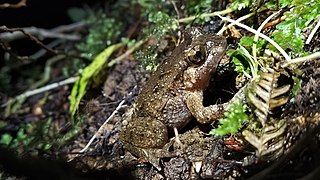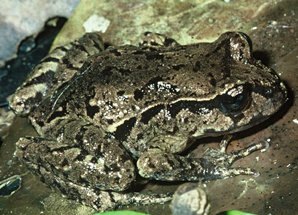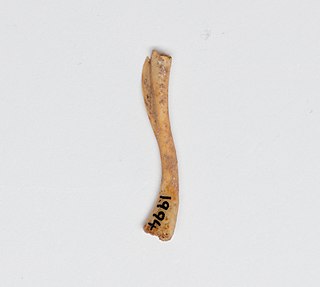
Since the 1980s, decreases in amphibian populations, including population decline and localized mass extinctions, have been observed in locations all over the world. These declines are known as one of the most critical threats to global biodiversity.

Leiopelma is a genus of New Zealand primitive frogs, belonging to the suborder Archaeobatrachia. It is the only genus in the monotypic family Leiopelmatidae. The leiopelmatids' relatively basal form indicates they have an ancient lineage. While some taxonomists have suggested combining the North American frogs of the genus Ascaphus in the family Ascaphidae with the New Zealand frogs of the genus Leiopelma in the family Leiopelmatidae, the current consensus is that these two groups constitute two separate families. The four extant species of Leiopelmatidae are only found in New Zealand.

Darwin’s frog, also called the Southern Darwin's frog, is a species of Chilean/Argentinian frog of the family Rhinodermatidae. It was discovered by Charles Darwin during his voyage on HMS Beagle. on a trip to Chile. In 1841, French zoologist André Marie Constant Duméril and his assistant Gabriel Bibron described and named Darwin's frog. The diet of R. darwinii consists mostly of herbivore invertebrates. R. darwinii is currently classified as an endangered species by the International Union for Conservation of Nature.

Chytridiomycosis is an infectious disease in amphibians, caused by the chytrid fungi Batrachochytrium dendrobatidis and Batrachochytrium salamandrivorans. Chytridiomycosis has been linked to dramatic population declines or extinctions of amphibian species in western North America, Central America, South America, eastern Australia, east Africa (Tanzania), and Dominica and Montserrat in the Caribbean. Much of the New World is also at risk of the disease arriving within the coming years. The fungus is capable of causing sporadic deaths in some amphibian populations and 100% mortality in others. No effective measure is known for control of the disease in wild populations. Various clinical signs are seen by individuals affected by the disease. A number of options are possible for controlling this disease-causing fungus, though none has proved to be feasible on a large scale. The disease has been proposed as a contributing factor to a global decline in amphibian populations that apparently has affected about 30% of the amphibian species of the world. Some research found evidence insufficient for linking chytrid fungi and chytridiomycosis to global amphibian declines, but more recent research establishes a connection and attributes the spread of the disease to its transmission through international trade routes into native ecosystems.

The Baw Baw frog is a critically endangered species of Australian frog as categorised on the IUCN Red List and listed under the Flora and Fauna Guarantee Act (1988). It has suffered a decline in population, mostly due to infection caused by chytrid fungus. Zoos Victoria has undertaken a breeding program to ensure survival of the species which commenced in 2010, and in October 2018 successfully collected the first eggs laid in captivity.

The mountain yellow-legged frog, also known as the southern mountain yellow-legged frog, is a species of true frog endemic to California in the United States. It occurs in the San Jacinto Mountains, San Bernardino Mountains, and San Gabriel Mountains in Southern California and the Southern Sierra Nevada. It is a federally listed endangered species, separated into two distinct population segments (DPS): a northern DPS, listed endangered in 2014, and a southern DPS that was listed endangered in 2002.

Batrachochytrium dendrobatidis, also known as Bd or the amphibian chytrid fungus, is a fungus that causes the disease chytridiomycosis in amphibians.

Hochstetter's frog or Hochstetter's New Zealand frog is a primitive frog native to New Zealand, one of only four extant species belonging to the taxonomic family Leiopelmatidae. They possess some of the most ancient features of any extant frogs in the world.

The Hamilton's frog is a primitive frog native to New Zealand, one of only four extant species belonging to the family Leiopelmatidae. New Zealand's frog species all are in the family Leiopelmatidae. The male remains with the eggs to protect them and allows the tadpoles to climb onto his back where they are kept moist. It is named in honour of Harold Hamilton the collector of the type specimen. The holotype is in the collection of the Museum of New Zealand Te Papa Tongarewa.

The Maud Island frog has been recently been synonymised with Hamilton's frog

The Panamanian golden frog, also known as Cerro Campana stubfoot toad and other names, is a species of toad endemic to Panama. Panamanian golden frogs inhabit the streams along the mountainous slopes of the Cordilleran cloud forests of west-central Panama. While the IUCN lists it as Critically Endangered, it may in fact have been extinct in the wild since 2007. Individuals have been collected for breeding in captivity in a bid to preserve the species. The alternative common name, Zetek's golden frog, and the epithet zeteki both commemorate the entomologist James Zetek.

Morelet's tree frog, also known as black-eyed leaf frog and popeye hyla, is a species of frog in the subfamily Phyllomedusinae. It is found in Belize, El Salvador, Guatemala, Honduras, and Mexico.

Agalychnis lemur, the lemur leaf frog or lemur frog, is a species of frog in the subfamily Phyllomedusinae. It is found in Costa Rica, Panama, and adjacent northwestern Colombia. It is classed as Critically Endangered and threatened by the fungal disease chytridiomycosis.

The green-eyed treefrog is a species of Australasian treefrog in the subfamily Pelodryadinae that occurs in the Wet Tropics of Australia.

The golden toad is an extinct species of true toad that was once abundant in a small, high-altitude region of about 4 square kilometres (1.5 sq mi) in an area north of the city of Monteverde, Costa Rica. It was endemic to elfin cloud forest. Also called the Monte Verde toad, Alajuela toad and orange toad, it is commonly considered the "poster child" for the amphibian decline crisis. This toad was first described in 1966 by herpetologist Jay Savage. The last sighting of a single male golden toad was on 15 May 1989, and it has since been classified as extinct by the International Union for Conservation of Nature (IUCN).

Ecnomiohyla rabborum, commonly known as Rabbs' fringe-limbed treefrog, is a possibly extinct species of frog in the family Hylidae. They were relatively large frogs that inhabited the forest canopies of central Panama. Like other members of the genus Ecnomiohyla, they were capable of gliding by spreading their enormous and fully webbed hands and feet during descent. The males of the species were highly territorial and would guard water-filled tree holes used for breeding. They were also the ones responsible for guarding and caring for the young, including providing food. They were the only known species of frog where the tadpoles derived nutrition by feeding on the skin cells of their fathers.
Leiopelma auroraensis, known as the Aurora frog, is an extinct species of frog that was found in New Zealand. One subfossil of the Aurora frog has been discovered in the Aurora Cave, Fiordland, New Zealand. It measured about 60 mm from the snout to the vent. It is named after the Aurora Cave for where it was found. The other extinct New Zealand frogs are Markham's frog and Waitomo frog. Aurora frog probably was a local form that had evolved from the more widely distributed Markham's frog.

Markham's frog is one of three extinct New Zealand frog species, the others being the Aurora frog and Waitomo frog. Subfossil bones used to describe the species were discovered at Honeycomb Hill Cave, South Island, New Zealand, but it once occurred on both South and North Islands. It is estimated that it grew between 50 and 60 mm from snout to vent and it appears to have been a very robust animal.
The Waitomo frog is an extinct species of the genus Leiopelma from New Zealand.

Evan Graham Turbott was a New Zealand ornithologist, zoologist, and museum administrator. He served as director of the Auckland Institute and Museum from 1964 to 1979.



















